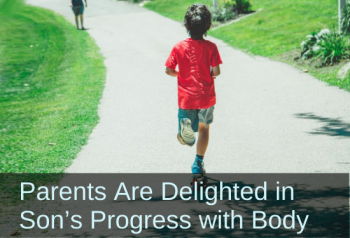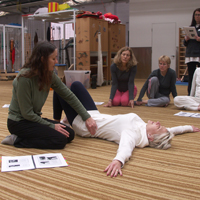OT Focuses on Reflex Foundation, Builds Focus, Strength, Self-Regulation, Pencil Grip
Submitted by By M.S., OTR/L

|
Before
|
After
|
|
Poor core strength
|
Core strength improved; can sit/stand still for longer
|
|
C-curved posture dure to poor core strength
|
Posture improved
|
|
Entire body would move when head turned
|
Able to isolate head movements without entire body following
|
|
Significant deficits in basic body awareness, balance, and coordination resulting in frequent bumping, tripping, and falling
|
More body control; less falling and tripping
|
|
Intense emotional outbursts during transitions or non-preferred activities
|
More in control of his emotions
|
|
Unable to hold a pencil in a developmentally appropriate grasp
|
Grasp is more developmentally appropriate (i.e. went from a supinate grasp to quadrupod grasp)
|
Luke is a 7-year-old boy who was referred to our clinic for an initial occupational therapy evaluation to address challenges with motor coordination, fine motor, and handwriting skills. It was clear almost immediately upon meeting Luke that he faced significant deficits in basic body awareness, balance, and coordination. He would frequently stumble after taking a few steps, crash or bump into walls or furniture, and was virtually unable to sit still. Luke’s balance and coordination were so poor that once a sudden gust of wind knocked him off balance and caused him to crash into the side of a park bench, leaving him with a nasty bruise on the side of his face. Luke’s core strength was also poor to non-existent, as his spine quickly assumed a C-curve shape when seated. Despite approaching the age where writing demands in school quickly increased, Luke was unable to hold a pencil in a developmentally appropriate grasp. His letter formation was poor with poor distal control. His letters were formed with shaky lines and showed poor sizing, alignment, and spacing.
Since Luke was clearly not participating at the level of his peers on basic balance and coordination tasks, I chose to work first on integrating his TLR reflex [from the Brain and Sensory Foundations® course]. When I tested for the presence of a retained TLR, Luke immediately lost balance and almost fell backwards after extending his head. Next, I asked Luke to move his feet in the duck and pigeon positions. Luke’s arms immediately moved the same direction as his feet, indicating poor dissociation of the upper and lower parts of the body.
I first introduced Luke to rhythmic movement #1, which we completed passively. I chose passive movements as I knew it would be challenging for Luke to attempt these movements actively using smooth, coordinated movement. At first, Luke was only able to tolerate 1 minute of passive movement at a time, but after several sessions, he was able to tolerate 2-3 minutes. Luke really enjoyed having me sing silly songs during the movements, and liked completing the movements with his eyes open and the lights in the room off. After 4-5 sessions, I began introducing the other rhythmic movements into our sessions, which he tolerated well. I provided Luke’s family with a demonstration of the rhythmic movements, which they reported completing at least 5 minutes of before bed each night.
In addition to the rhythmic movements [from the Brain and Sensory Foundations® course], I chose therapeutic activities that involved keeping Luke on the floor in prone as well as movements that involved rolling, rocking, and spinning. Examples included ‘roly poly’ movements back and forth in supine, log rolls, and controlled spinning in a lycra swing to provide additional proprioceptive input needed for improved body awareness. I chose these to help mature his vestibular system and inhibit activation of his TLR, which seemed to be constantly throwing him off balance in his everyday life. After implementing these movements and activities, Luke not only improved his core strength but also his ability to isolate his head movements without his entire body following. His favorite game by far was ‘belly ball,’ where we would face each other on our bellies and pass a large exercise ball back and forth.
After 2-3 months, Luke’s parents were delighted in the progress he made. They reported ‘he doesn’t fall or trip as much now’ and ‘can control his body more.’ I noticed Luke was now able to ride a scooter without falling or injuring himself, could sit/stand still for longer amounts of time, and was standing and sitting up straighter. He was also more in control of his emotions and was no longer displaying intense emotional outbursts during transitions or non-preferred activities.
Since Luke had so many unintegrated reflexes, we didn’t spend a lot of time on handwriting during our sessions. However, I did notice his grasp became more developmentally appropriate (i.e. went from a supinate grasp to quadrupod grasp) after several months of using the rhythmic movement and reflex integration tools.
Also, his distal control was much improved, resulting in increased stability during writing/drawing activities with fewer shaky lines.
Luke's letter formation is still a work in progress, as he does not yet consistently form letters from the top-down. I’m hoping with continued intervention and use of the reflex integration tools that he will have the strong foundation needed to succeed at those higher-level writing skills.
Focusing on these foundational skills and reflexes [from the Brain and Sensory Foundations® course] was crucial for Luke to make any progress in higher level skills such as handwriting. I was amazed at the power of the rhythmic movements and reflex integration tools in helping Luke become a happier, more successful child who could more successfully participate at the level of his peers.
(Edited, emphasis added)


